The document discusses functional programming with Immutable.js. It introduces immutability versus mutability, with examples of immutable objects in code like numbers and strings in JavaScript. It discusses how some array methods are immutable while others mutate the array. The document also covers pure functions, structural sharing with persistent data structures, and performance enhancements available with immutable data structures. It provides examples of using Immutable.js to create immutable Maps, Lists, and nested objects and modify them immutably.



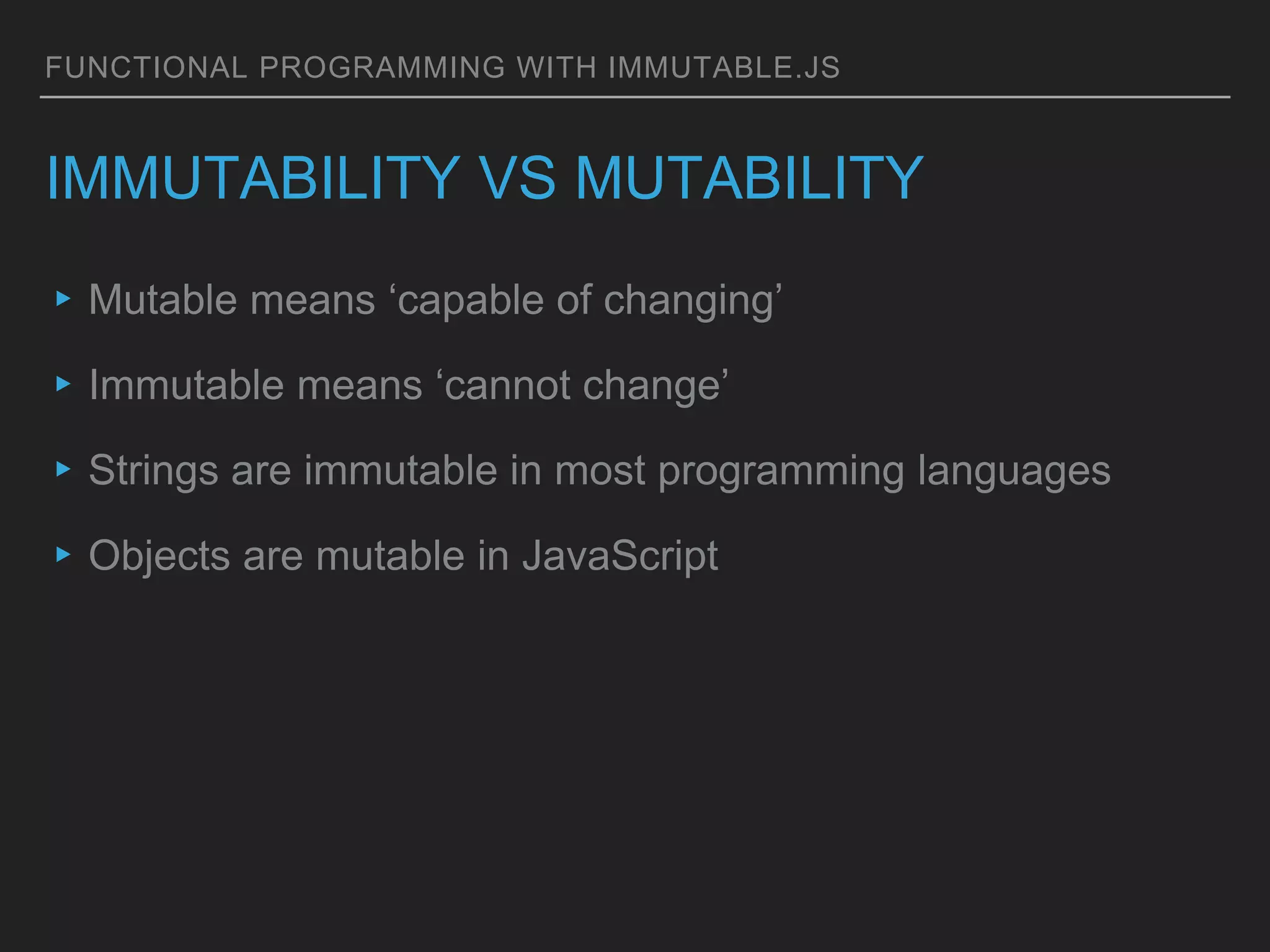
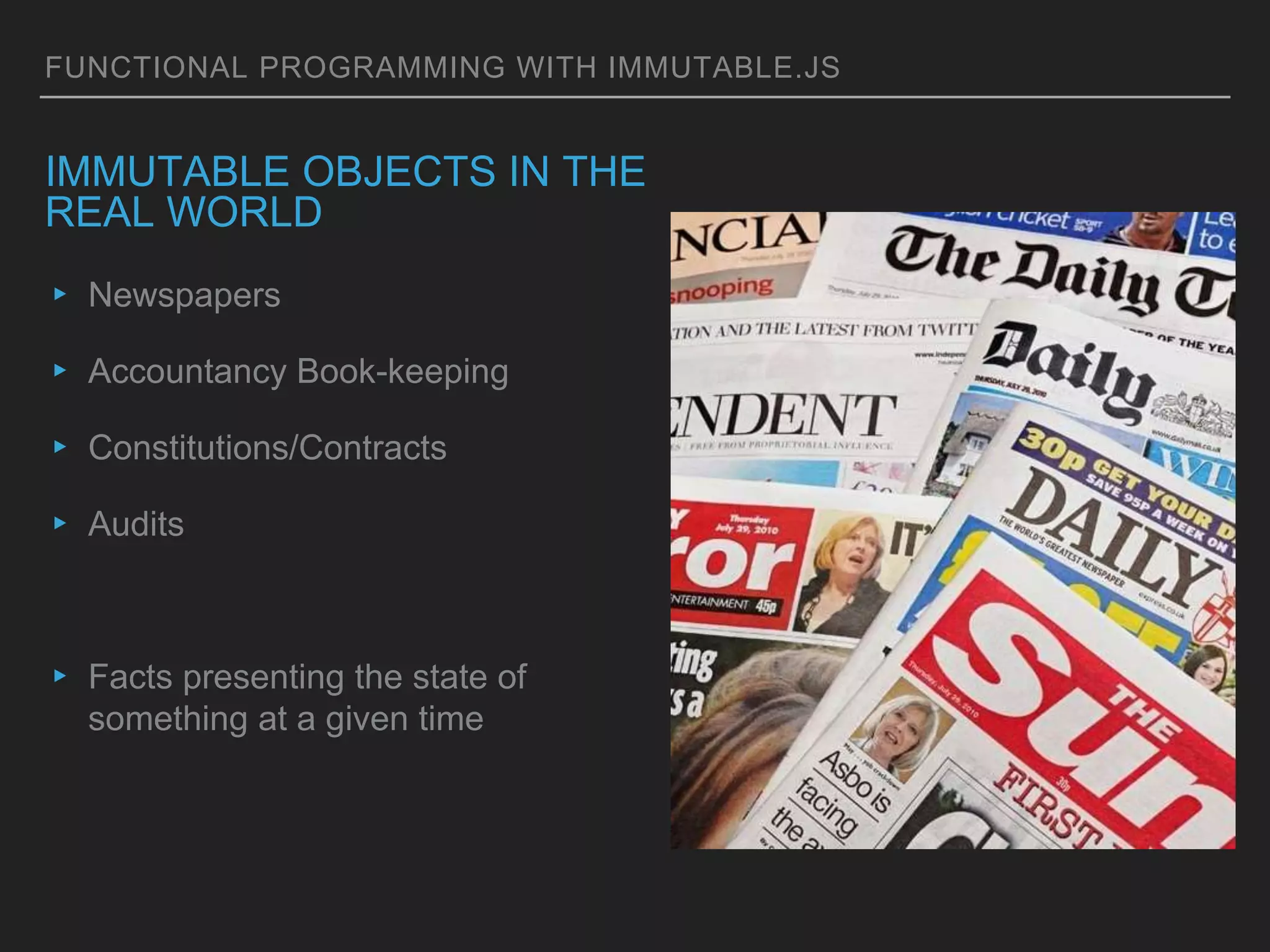

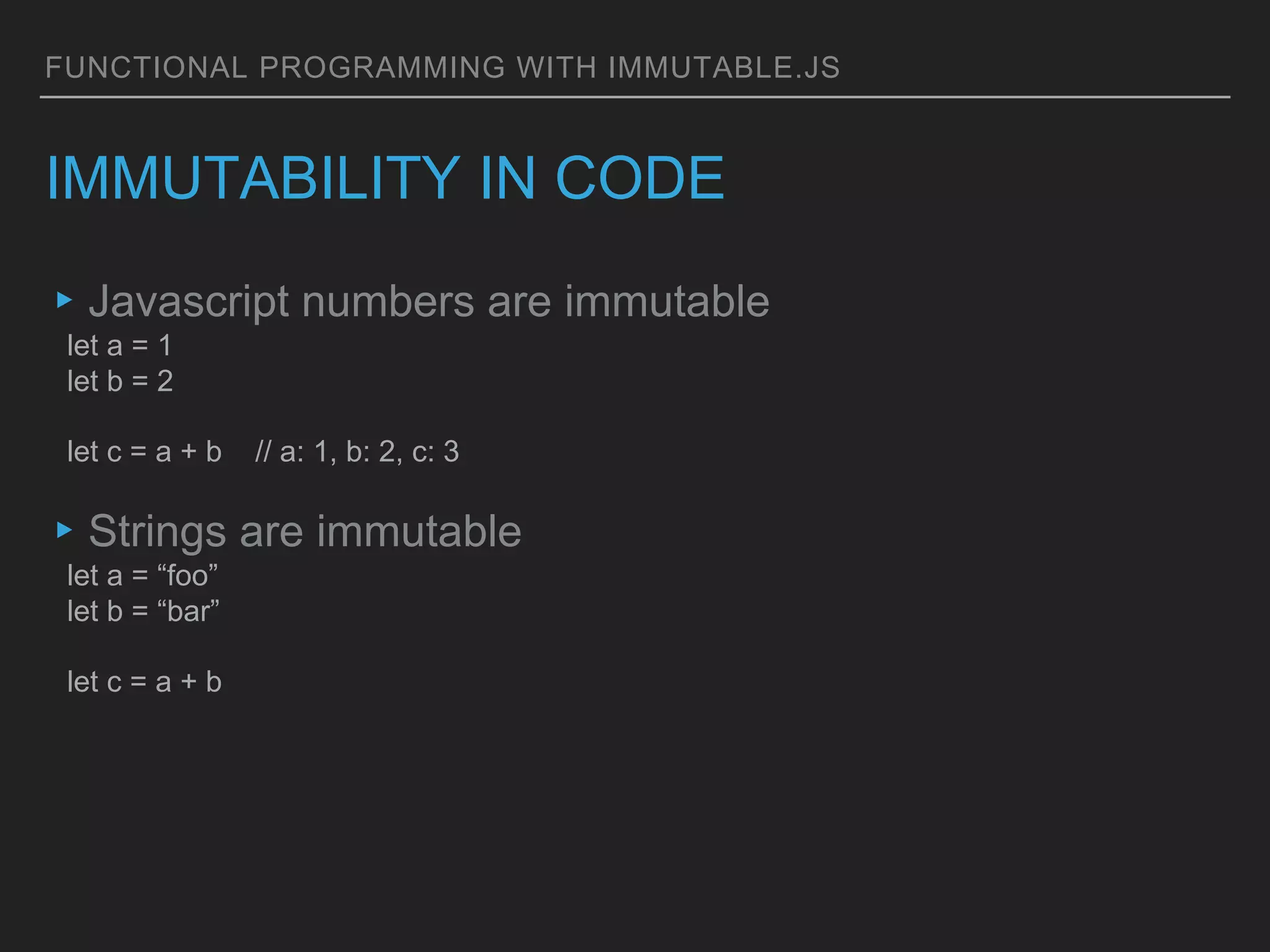

![FUNCTIONAL PROGRAMMING WITH IMMUTABLE.JS IMMUTABILITY IN CODE ▸Some array methods are immutable let a = [ 1, 2 ] let b = [ 3, 4 ] let c = a.concat(b) ▸Others are not let a = [ 1, 2, 5 ] let b = a.push(8)](https://image.slidesharecdn.com/functionalprogrammingpowerpoint-170523093123/75/Functional-programming-with-Immutable-JS-9-2048.jpg)
![FUNCTIONAL PROGRAMMING WITH IMMUTABLE.JS IMMUTABILITY IN CODE ▸Some array methods are immutable let a = [ 1, 2 ] let b = [ 3, 4 ] let c = a.concat(b) // a: [ 1, 2 ] // b: [ 3, 4 ] // c: [ 1, 2, 3, 4 ] ▸Others are not let a = [ 1, 2, 5 ] let b = a.push(8)](https://image.slidesharecdn.com/functionalprogrammingpowerpoint-170523093123/75/Functional-programming-with-Immutable-JS-10-2048.jpg)
![FUNCTIONAL PROGRAMMING WITH IMMUTABLE.JS IMMUTABILITY IN CODE ▸Some array methods are immutable let a = [ 1, 2 ] let b = [ 3, 4 ] let c = a.concat(b) // a: [ 1, 2 ] // b: [ 3, 4 ] // c: [ 1, 2, 3, 4 ] ▸Others are not let a = [ 1, 2, 5 ] let b = a.push(8) // a: [ 1, 2, 5, 8 ]](https://image.slidesharecdn.com/functionalprogrammingpowerpoint-170523093123/75/Functional-programming-with-Immutable-JS-11-2048.jpg)
![FUNCTIONAL PROGRAMMING WITH IMMUTABLE.JS IMMUTABILITY IN CODE ▸Some array methods are immutable let a = [ 1, 2 ] let b = [ 3, 4 ] let c = a.concat(b) // a: [ 1, 2 ] // b: [ 3, 4 ] // c: [ 1, 2, 3, 4 ] ▸Others are not let a = [ 1, 2, 5 ] let b = a.push(8) // a: [ 1, 2, 5, 8 ] // b: 4](https://image.slidesharecdn.com/functionalprogrammingpowerpoint-170523093123/75/Functional-programming-with-Immutable-JS-12-2048.jpg)
![FUNCTIONAL PROGRAMMING WITH IMMUTABLE.JS OBJECT-ORIENTATED PROGRAMMING TENDS TO MUTABILITYclass Kettle { int temperature = 0; int getTemperature() { return this.temperature; } void boil() { this.temperature = 100; } } class Order { int id; drink[] drinks; Order(id) { this.id = id; } addDrink(drink) { this.drinks.push(drink); } process() { } } class Coffee extends Beverage { ...](https://image.slidesharecdn.com/functionalprogrammingpowerpoint-170523093123/75/Functional-programming-with-Immutable-JS-13-2048.jpg)
![FUNCTIONAL PROGRAMMING WITH IMMUTABLE.JS MAKING THIS OPERATION IMMUTABLE var list1 = Immutable.List.of(1, 2) var list2 = list1.push(3, 4, 5) // list1: [ 1, 2 ] // list2: [ 1, 2, 3, 4, 5 ]](https://image.slidesharecdn.com/functionalprogrammingpowerpoint-170523093123/75/Functional-programming-with-Immutable-JS-14-2048.jpg)


![FUNCTIONAL PROGRAMMING WITH IMMUTABLE.JS ARRAY MAP a = [1, 2, 5] function double(value) { return value * 2; } function addOne(value) { return + 1; } b = a.map(double).map(addOne) // b: [3, 5, 11]](https://image.slidesharecdn.com/functionalprogrammingpowerpoint-170523093123/75/Functional-programming-with-Immutable-JS-17-2048.jpg)
![FUNCTIONAL PROGRAMMING WITH IMMUTABLE.JS ARRAY MAP a = [1, 2, 5] const double = (value) => value * 2; const addOne = (value) => value + 1; b = a.map(double).map(addOne) // b: [3, 5, 11]](https://image.slidesharecdn.com/functionalprogrammingpowerpoint-170523093123/75/Functional-programming-with-Immutable-JS-18-2048.jpg)





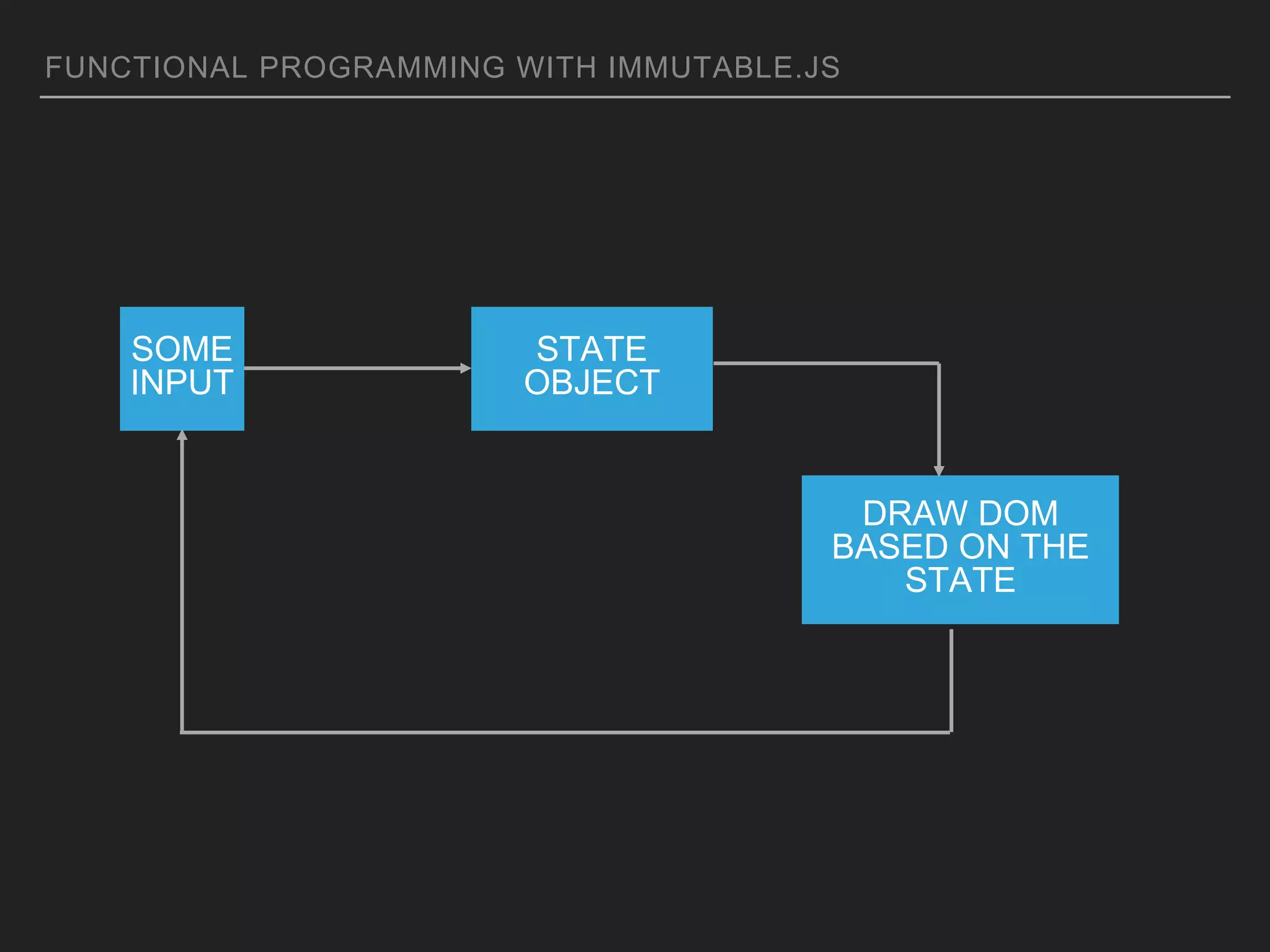


![FUNCTIONAL PROGRAMMING WITH IMMUTABLE.JS COMPARING TWO OBJECTS IN JAVASCRIPT function compare2Objects (x, y) { var p; // remember that NaN === NaN returns false // and isNaN(undefined) returns true if (isNaN(x) && isNaN(y) && typeof x === 'number' && typeof y === 'number') { return true; } // Compare primitives and functions. // Check if both arguments link to the same object. // Especially useful on the step where we compare prototypes if (x === y) { return true; } // Works in case when functions are created in constructor. // Comparing dates is a common scenario. Another built-ins? // We can even handle functions passed across iframes if ((typeof x === 'function' && typeof y === 'function') || (x instanceof Date && y instanceof Date) || (x instanceof RegExp && y instanceof RegExp) || (x instanceof String && y instanceof String) || (x instanceof Number && y instanceof Number)) { return x.toString() === y.toString(); } // At last checking prototypes as good as we can if (!(x instanceof Object && y instanceof Object)) { return false; } if (x.isPrototypeOf(y) || y.isPrototypeOf(x)) { return false; } if (x.constructor !== y.constructor) { return false; } if (x.prototype !== y.prototype) { return false; } // Check for infinitive linking loops if (leftChain.indexOf(x) > -1 || rightChain.indexOf(y) > -1) { return false; } // Quick checking of one object being a subset of another. // todo: cache the structure of arguments[0] for performance for (p in y) { if (y.hasOwnProperty(p) !== x.hasOwnProperty(p)) { return false; } else if (typeof y[p] !== typeof x[p]) { return false; } } for (p in x) { if (y.hasOwnProperty(p) !== x.hasOwnProperty(p)) { return false; } else if (typeof y[p] !== typeof x[p]) { return false; } switch (typeof (x[p])) { case 'object': case 'function': leftChain.push(x); rightChain.push(y); if (!compare2Objects (x[p], y[p])) { return false; } leftChain.pop(); rightChain.pop(); break; default: if (x[p] !== y[p]) { return false; } break; } }](https://image.slidesharecdn.com/functionalprogrammingpowerpoint-170523093123/75/Functional-programming-with-Immutable-JS-27-2048.jpg)

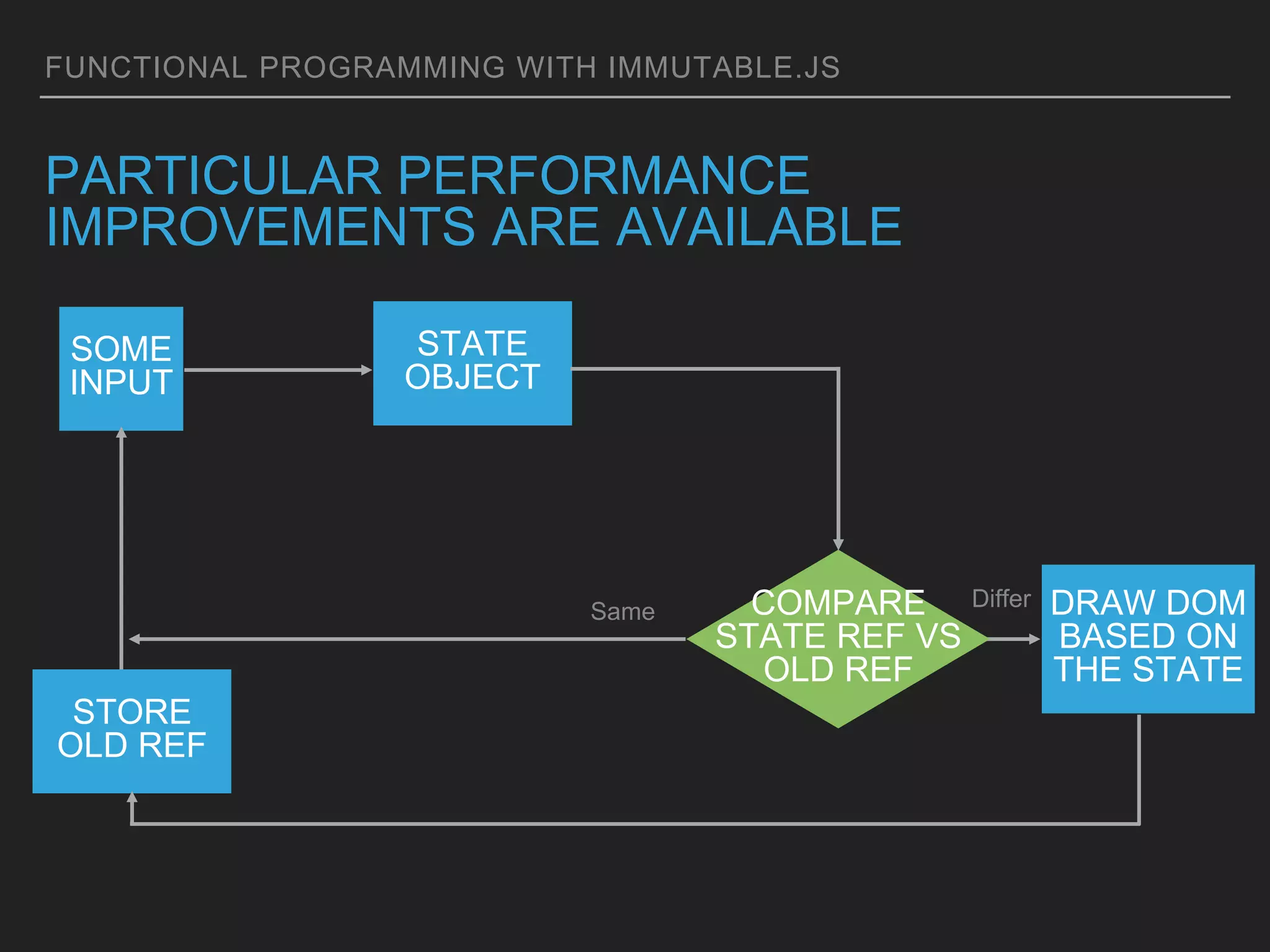

![FUNCTIONAL PROGRAMMING WITH IMMUTABLE.JS PERSISTENT DATA STRUCTURES 1 List.of([ 1, 2, 3, 5, 8 ]).push(13) 2 3 50x0012 8](https://image.slidesharecdn.com/functionalprogrammingpowerpoint-170523093123/75/Functional-programming-with-Immutable-JS-31-2048.jpg)
![FUNCTIONAL PROGRAMMING WITH IMMUTABLE.JS PERSISTENT DATA STRUCTURES 1 2 3 50x0012 1 2 3 50x0042 8 8 13 List.of([ 1, 2, 3, 5, 8 ]).push(13)](https://image.slidesharecdn.com/functionalprogrammingpowerpoint-170523093123/75/Functional-programming-with-Immutable-JS-32-2048.jpg)

![FUNCTIONAL PROGRAMMING WITH IMMUTABLE.JS STRUCTURAL SHARING 2 3 5 0x0012 1 8 List.of([ 1, 2, 3, 5, 8 ]).push(13)](https://image.slidesharecdn.com/functionalprogrammingpowerpoint-170523093123/75/Functional-programming-with-Immutable-JS-34-2048.jpg)
![FUNCTIONAL PROGRAMMING WITH IMMUTABLE.JS STRUCTURAL SHARING 2 3 5 0x0012 1 8 1 8 13 0x0042 List.of([ 1, 2, 3, 5, 8 ]).push(13)](https://image.slidesharecdn.com/functionalprogrammingpowerpoint-170523093123/75/Functional-programming-with-Immutable-JS-35-2048.jpg)


![FUNCTIONAL PROGRAMMING WITH IMMUTABLE.JS IMMUTABLE.JS var map = Immutable.Map({ a: 1, b: 2, c: 3 }) map .set('b', 50) .get('b') // 50 var list = Immutable.List.of(1, 2) list .push(3, 4, 5) .unshift(0) .concat(list2, list3) .get(0) .size var nested = Immutable.fromJS({ user: { profile: { name: 'John' } } }) nested .mergeDeep({ user: { profile: { age: 90 } } }) .setIn([ 'user', 'profile', 'name' ], 'Jack') .updateIn([ 'user', 'profile', 'name' ], (s) => s.toUpperCase()) .getIn(['user', 'profile', 'name']) // 'JACK'](https://image.slidesharecdn.com/functionalprogrammingpowerpoint-170523093123/75/Functional-programming-with-Immutable-JS-38-2048.jpg)